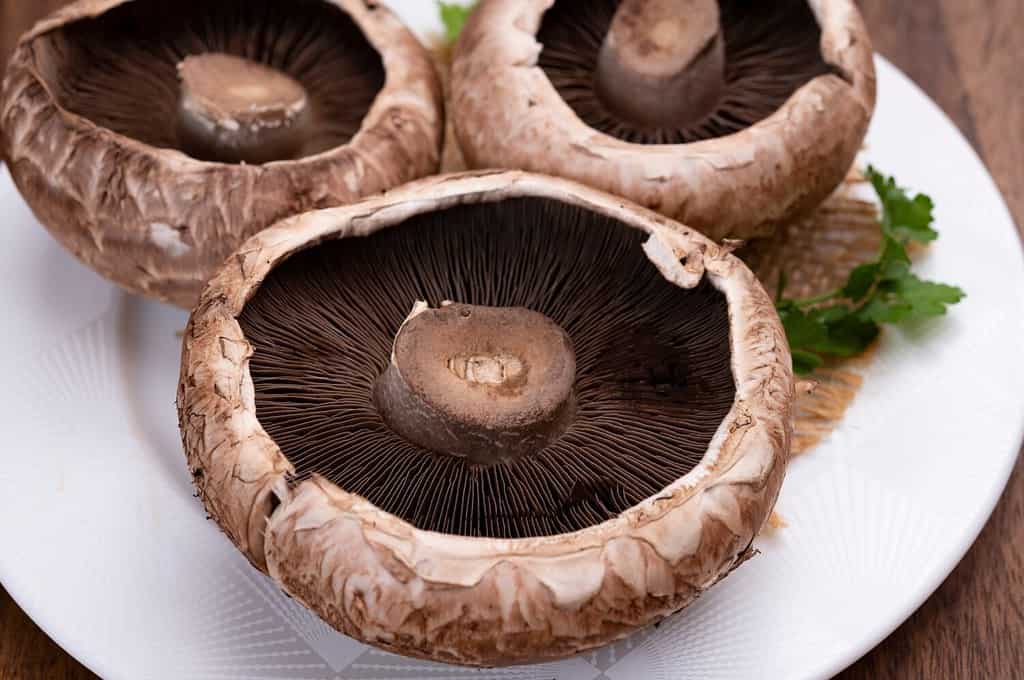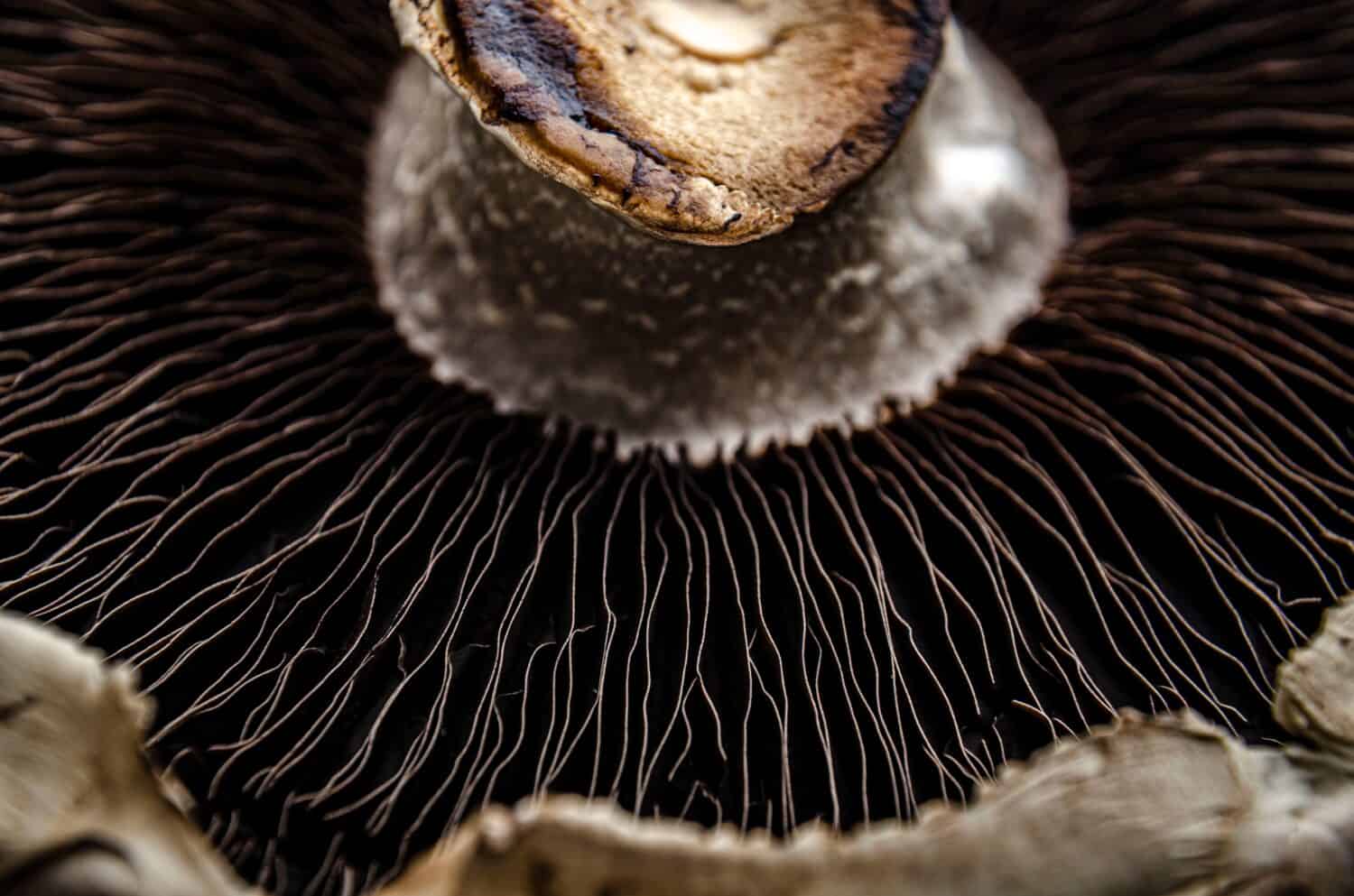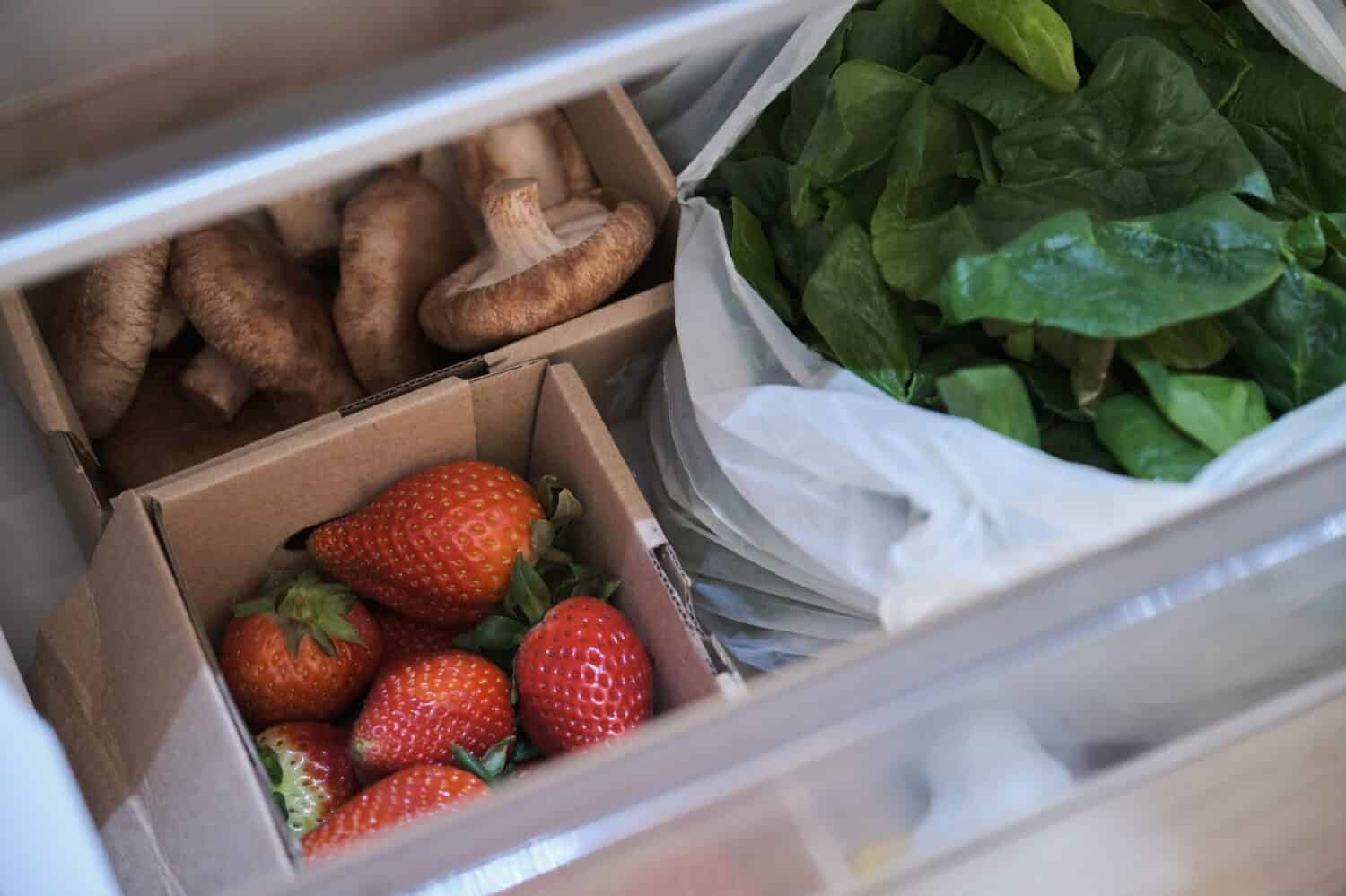If you’ve come home with a big batch of portobello mushrooms, you may be wondering about the best method of storage. Poor storing of mushrooms can quickly lead to spoilage, and portobellos are no exception.
Read on to learn how to store portobello mushrooms, as well as classification information, and identifying this species in the wild.
What Are Portobello Mushrooms?
Portobello mushrooms are a cultivated form of Agaricus bisporus, one of the most widely grown culinary mushrooms in the world. The common button mushrooms and creminis are also cultivated versions of Agaricus bisporus. Differences between these mushrooms are simply the time at which they are harvested. Growers harvest button mushrooms in their immature form when the partial veil is still intact, covering the gills. In contrast, portobello mushrooms are harvested at full maturity when the caps are almost fully expanded and the underside reveals dark brown gills.
In the wild, Agaricus bisporus is endemic to temperate grasslands, manure-rich soil, and compost piles across Asia, Europe, and North America. Although this species isn’t found often in the wild, there are quite a few other similar species that are commonly found. If harvesting wild specimens, make sure to have 100% confirmation of your finds as this mushroom does have poisonous look-alikes, such as Agaricus xanthodermus.

A good look at the underside of a portobello mushroom
©barmalini/Shutterstock.com
How to Store Portobello Mushrooms: Identifying Wild Specimens
If you plan on harvesting and storing wild specimens of Agaricus bisporus, it’s crucial to properly identify this species. While the most likely poisonous species to confuse with A. bisporus is A. xanthodermus, an inexperienced forager could even confuse this mushroom with the deadly Amanita bisporigera. Luckily, a huge, and easily distinguishable difference between the two is that Amanita bisporigera has stark white gills, while Agaricus bisporus features pinkish-brown to dark brown gills. There are many other differences between the deadly Amanitas and Agaricus species as well.
Cap of Portobello Mushrooms
At the life stage that people consider A. bisporus to be portobellos, the mushroom is fully mature and the cap has expanded outward to a flat or nearly flat position. The caps are typically quite meaty and plump, and the color ranges from light tan to chestnut brown. At maturity, the cap also may take on a finely scaly appearance. The cap (aka the pileus) typically bruises pinkish to reddish when rubbed. If you cut it open, you will see the flesh is white and firm, also bruising pinkish-red when cut, and then slowly turning a brownish color. At maturity, portobello caps are often 5-6 inches across.

A close up of the scaly look to the cap of
Agaricus bisporus©RVillalon/Shutterstock.com
Gills
The gills of portobellos are free from the stem (aka the stipe). This means that there is a narrow space between where the stipe meets the pileus and where the gills begin underneath the cap. At maturity, the short, frequently spaced gills should be dark brown. The spore print is dark brown.

A close up of the gills of a portobello mushroom.
©Banan Sindi/Shutterstock.com
Stipe
An off-white partial veil ring may or may not be present on the upper portion of the stipe of a mature Agaricus bisporus specimen. The stipe tends to have a uniform appearance from the base to the top. It may be bald on covered in fine, small scales. Upon bruising or cutting, the stipe tends to bruise reddish-brown. It is normally more girthy in stature than most mushrooms you’ll find in the store or in the wild.

A close up of the stem of a portobello.
©freedomnaruk/Shutterstock.com
Comparing with Agaricus xanthodermus
If you will be hunting for wild A. bisporus, it’s important to be able to distinguish this mushroom from one of its closest poisonous lookalikes, Agaricus xanthodermus. This mushroom is not deadly, but ingestion often results in intense gastrointestinal upset. One of the quickest ways to distinguish A. bisporus from A. xanthodermus is the color the flesh may stain upon bruising or cutting. One common name of A. xanthodermus is “yellow stainer” in reference to the chrome yellow staining that occurs upon damage. The base of the stipe is also often bright yellow. If present on a mature species, the partial veil ring is also often tinged with bright yellow. Smelling the mushroom can also help, A. xanthodermus will sometimes have a phenolic smell. You may need to pinch the base or even heat it up in the microwave quickly to get the smell.

Sometimes the yellow staining of
Agaricus xanthodermuscan be faint.
©Kazakov Maksim/Shutterstock.com
How to Store Portobello Mushrooms: Harvested or Purchased
Whether you’ve bought your portobellos from a store or have foraged a flush of mature A. bisporus, you’ll want to make sure you properly store them. Most mushroom species deteriorate rather quickly, so proper storage will ensure that you don’t needlessly waste your food.
The best method for storing any mushroom, including portobellos, is to keep the mushrooms out of the light, allow some amount of air exchange, and prevent moisture accumulation. UV damage, oxidation, high temperatures, physical damage, and moisture accumulation are some of the biggest contributors to mushroom spoilage.
Fridge Storage
To combat these factors, your best bet is to store the mushrooms uncut, in a breathable container, out of direct sunlight, in a cool place, and in a container that prevents excess moisture buildup. Of course, one of the best modern methods for this type of fresh storage is to use the fridge.
By storing your portobellos in a dry paper bag in the fridge, you’ll likely get 5-7 days of freshness. If you slice your mushrooms before storing them, you may only get half of this time before the mushrooms show signs of oxidation damage. Oxidation often leads to a rancid taste, discoloration, poor-quality texture and even bacterial growth.

Letting your mushrooms breathe and not keeping them in a sealed container is best.
©Ladanifer/Shutterstock.com
How to Store Portobello Mushrooms: Pantry Storage
If you don’t have access to fridge storage, the next best option is to use a clean, dry pantry. Ideally, the pantry should be out of direct sunlight. This option won’t provide the same level of cold storage. However, a clean, dry pantry will protect the mushrooms from UV damage, moisture buildup, and damage from jostling.

The pantry can be used for short term storage, but it’s more suited for pickled or dehydrated mushrooms.
©alicja neumiler/Shutterstock.com
The photo featured at the top of this post is © Yulia von Eisenstein/Shutterstock.com
The information presented on or through the Website is made available solely for general informational purposes. We do not warrant the accuracy, completeness, or usefulness of this information. Any reliance you place on such information is strictly at your own risk. We disclaim all liability and responsibility arising from any reliance placed on such materials by you or any other visitor to the Website, or by anyone who may be informed of any of its contents. None of the statements or claims on the Website should be taken as medical advice, health advice, or as confirmation that a plant, fungus, or other item is safe for consumption or will provide any health benefits. Anyone considering the health benefits of particular plant, fungus, or other item should first consult with a doctor or other medical professional. The statements made within this Website have not been evaluated by the Food and Drug Administration. These statements are not intended to diagnose, treat, cure or prevent any disease.
Thank you for reading! Have some feedback for us? Contact the AZ Animals editorial team.







